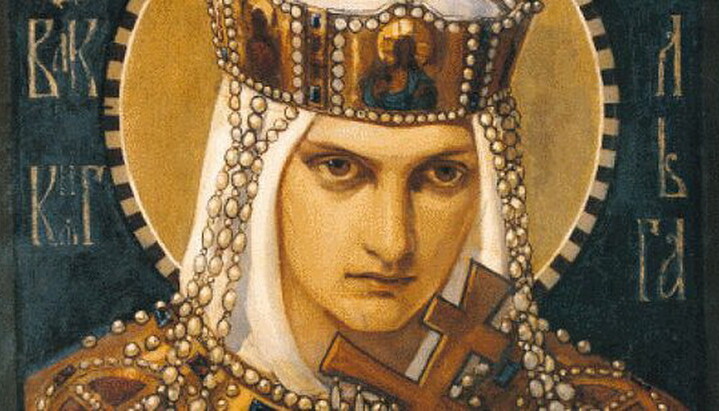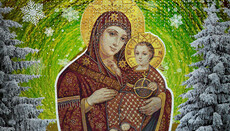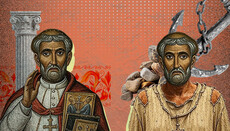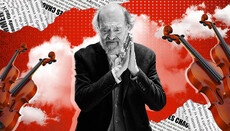What Princess Olga did for Rus’

In the Church’s calendar, Olga is honored as a saint equal to the apostles. This is entirely fitting, though there is still much we fail to appreciate about her true legacy.
The troparion to St. Olga says: “…having sought God, the Creator of all, and having found Him, you received rebirth through Baptism…” – highlighting that the Princess of Kyiv was guided primarily by religious motives in embracing Christianity. And that is true. But it is also a fact that rulers throughout history have often been motivated by politics when adopting or changing religion. Sometimes these motives are so intertwined it’s nearly impossible to separate them.
Yet there are moments that reveal what mattered most: truth or political gain. Such moments existed in St. Olga’s life.
Historians still debate her date of birth, with estimates ranging widely – from 894 to 928. The claim that she was from Pskov is also interpreted in various ways. Some believe it refers to the Russian region of Pskov, though not the city (which did not yet exist), while others suggest the Bulgarian city of Pliska, then the capital, or a settlement in the Carpathians called Plesnesk.
The story that she was a commoner who rowed a ferry emerged only in the mid-16th century in a hagiography written in Moscow by the priest Sylvester, confessor to Ivan the Terrible. It's likely a romantic invention: the tale of a clever and beautiful peasant girl from a remote village who won the heart of the Prince of Kyiv.
More likely, though, the truth was different. Olga (in Norse form, Helga) may have been the daughter of a Bulgarian prince, as one version of the Primary Chronicle says, or the daughter of the princely commander Oleg, according to the Typographic Chronicle (15th century). Most plausibly, she was the daughter of the overseer of the ferry on the Velikaya River – which might explain the entire ferry story.
But that ferry wasn’t a poor man's boat ferrying random travelers. It was a key node on the famous trade route “from the Varangians to the Greeks,” comparable in importance to a modern port like Rotterdam. Control over that crossing was extremely valuable, and its overseer belonged to the social elite.
So Olga’s marriage to Prince Igor (Norse: Ingvar) was by no means a misalliance.
In Kyiv, Igor ruled from 912 to 945. His reign ended when he demanded extra tribute from the Drevlians and was killed. His son, Sviatoslav, just three years old, became prince in name, while real power lay with his mother, Princess Olga.
The Primary Chronicle gives a detailed account of Olga’s revenge on the Drevlians for her husband's murder – carried out in four calculated, brutal stages, with deception and cruelty. Including such unflattering details in a saint’s biography suggests they really happened.
As for her baptism, there are no precise records. The Primary Chronicle claims she was baptized in Constantinople by the Patriarch himself, with Emperor Constantine VII Porphyrogennetos as her godfather. Other sources suggest she arrived in Constantinople already baptized.
The Chronicle offers a colorful but improbable tale: Constantine was allegedly so struck by Olga’s beauty and intelligence that he proposed marriage, which she skillfully evaded.
“Seeing that she was very comely and intelligent, the Emperor was amazed at her wisdom, spoke with her, and said: ‘You are worthy to reign with us in this city.’”
According to the Chronicle, she first refused, saying she was unbaptized. She then agreed to baptism only if the Emperor himself would be her godfather. After being baptized, she refused marriage on the grounds that he was now her spiritual father.
The Chronicle never explains how the highly educated Constantine failed to see through such an obvious ruse, nor why Olga would reject the immense advantages such a marriage offered her and her realm.
Still, the very presence of this marriage proposal theme suggests that dynastic alliance was indeed a central or at least significant aim of her visit to Constantinople.
That visit took place in 957, and there’s a detailed contemporary account in De Ceremoniis by Constantine VII himself. According to that record, Constantine received Olga twice at court. While Russian chronicles describe lavish receptions and gifts, the actual ceremonial treatment was modest –comparable to that given to a Saracen envoy received around the same time.
The fact that Olga had to wait a long time in Constantinople (from April to October 957), that she twice petitioned for audiences, and that no major political changes resulted from the mission, all suggest the visit was a failure. She did not achieve her aims.
But what did she want?
Given the context, the likeliest answer is that Olga hoped to forge dynastic ties with the imperial family – perhaps by securing a marriage between her son Sviatoslav and a Byzantine princess – and to arrange the Christianization of her people. These goals were deeply linked.
Christianization was already brewing in Rus’ but faced major obstacles, with a powerful pagan faction.
Her son Sviatoslav, about fifteen at the time, was temperamentally drawn to the pagan side. But the Christian party was also strong. Even during Igor’s reign, there is evidence of many Christians in the army and among the elite.
For instance, in the 944 treaty with Byzantium it says: “If anyone from the Rus’ side breaks this peace, let those who have accepted baptism receive God’s punishment in this age and the next. And those who are not baptized, let them receive neither help from God nor from Perun...”
Notice Christians are mentioned first. They also swore their oaths in the Church of St. Elijah in Constantinople, while the pagans swore at the idol of Perun. Many Rus’ merchants were already Christians. They could build churches and hold services even under Igor, Olga, and even Sviatoslav himself. The only real persecutions came later under Prince Volodymyr – just before his own conversion.
In other words, Rus’ was at a tipping point: it could fully embrace Christianity or fall back into paganism. A marriage alliance with Byzantium could have tipped it decisively toward Christianity. But the Byzantines refused.
Olga was deeply disappointed. When the emperor later sent envoys demanding Rus’ supply troops – something presumably discussed in Constantinople – Olga’s reply was sharp and mocking.
The Chronicle recounts: “Olga returned to Kyiv. And the Greek emperor sent envoys to her saying: ‘I gave you many gifts, and you told me you would send me many gifts in return once you returned to Rus’: slaves, wax, furs, and troops in aid.’ Olga replied to the envoys: ‘Tell him: If you wait for me in the Pochayna as I waited for you in the Suda, then I will give you these things.’ And she sent them away.”
In other words, she demanded that the Byzantine Emperor himself come to Rus’ and wait for an audience as she had been forced to do in Constantinople.
And it was at this moment that Olga’s true aim became clear: was she seeking the political elevation of herself, her son, and her state – or the true faith in Christ?
If Princess Olga had not cared which Christianity Rus’ adopted – Eastern or Western – she could easily have turned to the West. The Pope of Rome at that time commanded an even larger flock than the Patriarch of Constantinople, and was arguably a more influential figure in Christendom. Moreover, there was Otto I the Great, King of the Germans, who ruled over much of Europe. The formation of the Holy Roman Empire was nearing completion, and Otto would soon, in 962, receive the imperial crown from the Pope himself.
Yes, forging ties with Byzantium was more prestigious, but the “Western option” was highly promising too. Had it not been for her religious convictions, Olga likely would have pursued it.
After the failure in Constantinople, the Western route was so obvious that Olga’s own circle attempted a risky maneuver: without her knowledge, they sent envoys to Otto I, supposedly on her behalf, asking him to send a bishop to Rus’ to baptize the people.
A 10th-century Western chronicle known as the Continuation of Regino relates that in 959: “There came to the king (Otto I the Great), as later turned out, falsely representing Queen Helena of the Rugians (Helenae reginae Rugorum), who had been baptized in Constantinople under Emperor Romanus, and they asked him to ordain a bishop and priests for that people.”
The next year such a bishop was consecrated, but he died before departing for Rus’. In 961, a man named Adalbert was appointed instead. He actually made it to Rus’, but was driven out in disgrace and barely escaped with his life. The chronicle records for 962: “In this year Adalbert, consecrated as bishop for the Rugians, returned because he had accomplished nothing he was sent for and saw all his efforts had been in vain. On the way back, some of his companions were killed, and he himself barely survived.”
Why such a harsh rejection of the “Western option,” which was clearly supported by much of the Kyiv elite?
Some suggest that Olga saw alliance with Byzantium – secured through baptism and/or dynastic marriage – as the only acceptable path for Rus’. But it seems even more likely that Olga consciously chose Byzantine Orthodoxy over Western Catholicism.
Without prospects of marrying into the imperial house, her son Sviatoslav decisively sided with the pagan faction to which he was already inclined. This meant the window for Olga’s reforms was closing – likely for decades. Politically, the “Western option” was the last chance to seize that moment. But for Princess Olga, the religious argument was far more important.
There was not yet a formal schism between Orthodoxy and Catholicism (that would come in 1054), and the Church was technically still united. But Eastern and Western religious traditions were already distinct and diverging rapidly.
Of course, it’s unlikely the Kyiv elite could parse the theological subtleties of East and West, but they certainly understood what the papacy represented.
This was the tail end of a notorious period in papal history known as the Pornocracy, one of the most shameful chapters of the Vatican’s past.
For 60 years, from 904 to 963, as historian E. Gergely writes, “wealthy and powerful women seeking influence placed their lovers, friends, and relatives on the papal throne. Those who displeased them were promptly deposed or removed.” Almost all contemporary chroniclers mention the corruption, depravity, and vice rampant in the Vatican during this time. Accounts of murder, adultery, and other scandals are well attested.
Unable to deny or minimize these events, Catholic historians have sometimes fallen back on the idea that only the “true Church” could survive such moral collapse. But this wasn't a crisis lasting just a year or two – it persisted for 60 years, long enough for word to reach even distant Rus’.
Pope John XII, who sat on the papal throne during Olga’s reign, is widely regarded as the most debauched pope of all.
Liutprand of Cremona, a contemporary chronicler, wrote: “…he committed adultery with Rainer’s widow, with his father’s concubine Stephana, with the widow Anna, and with his own niece. He turned the sacred palace into a brothel… he blinded his confessor Benedict, who then died; he killed John, the cardinal subdeacon, after castrating him… All clergy and laymen said he drank wine with the devil. They said that when gambling he invoked Jupiter, Venus, and other idols. They even said he did not celebrate Matins and did not make the sign of the cross.”
Later historian Louis-Marie Cormenin described him as: “John XII was fit to rival Elagabalus [the notorious 2nd-century Roman emperor known for extreme depravity]… a robber, murderer, and incestuous man, unworthy to represent Christ on the papal throne. This vile priest defiled the See of St. Peter for nine long years and deserves to be called the most loathsome of popes.”
Even supporters of the papacy concede, albeit in more measured language: “There can be no doubt that John XII was everything that a Pope, the Pastor of Christians, ought not to be.” (Horace Mann)
It was precisely this prospect – submitting Rus’ to “the most loathsome of popes” – that Princess Olga refused to entertain. For her, the choice of Eastern Orthodoxy was clear and deliberate.
When her plan for Rus’ to be baptized and linked by marriage to the Byzantine imperial house collapsed, she turned to what she could still do to strengthen Christianity in her land.
First, she tried to convince her son Sviatoslav of the truth of the Christian faith and the value of baptism. The Primary Chronicle says: “Living with her son Sviatoslav, she urged and taught him to be baptized. But he paid no attention, would not even listen. Yet if anyone wanted to be baptized, he did not forbid it but mocked them, for to the unbelievers the Christian faith was foolishness.”
She failed to make her son a Christian, but her efforts were not in vain: Sviatoslav remained relatively tolerant. The worst Christians faced during his reign were pagan taunts.
When Sviatoslav left Kyiv for his campaigns, Olga raised his sons – Yaropolk, Oleg, and Volodymyr. Her influence on each varied, but its fruits were evident in Yaropolk, who was inclined toward Christianity and by some accounts baptized, and later in Volodymyr, who would ultimately baptize Rus’.
Olga also destroyed pagan shrines and built churches – not across all Rus’, but in her own domains. She is known to have built the Church of Holy Wisdom (St. Sophia) in Kyiv, where she was buried after her death in 969.
The Primary Chronicle recounts: “After three days Olga died. And her son and grandsons and all the people wept for her with great lamentation. They took her and buried her in her place. And she had ordered them not to perform pagan funeral rites over her. She had a priest who buried blessed Olga. She was as a forerunner of the land’s Christianity, like the dawn before the sun, like the morning star before the light.”
Notably, Olga did not try to remove Sviatoslav from power despite their differences, did not plot a coup while he was away, nor did she strive to force her own will on history to become the “baptizer of Rus’” at any cost. Byzantine history is full of such examples, but Olga accepted God’s will humbly and did what she could under the circumstances. She showed sincere love for her son and grandsons.
St. Princess Olga, through her wisdom, humility, love, and care for her people, earned deep respect and authority. Her role in the Christianization of Rus’ was truly enormous. She provided an example of genuinely Christian life that inspired respect and a desire to follow her among her people. Her life set an example most of all for her grandson Volodymyr, who would complete the work she began.
Holy Equal-to-the-Apostles Princess Olga, pray to God for us!











